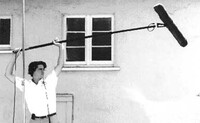![]() Camera-mounted mics may be adequate for general ambiance and background effects, but they lack the reach and versatility of boom mounted mics. Placing the microphone where the lens is may be convenient but it certainly does nothing to assist in picking up good sound.
Camera-mounted mics may be adequate for general ambiance and background effects, but they lack the reach and versatility of boom mounted mics. Placing the microphone where the lens is may be convenient but it certainly does nothing to assist in picking up good sound.
 For one thing, on-camera mics tend to hear zoom motors and other camera created noise.
For one thing, on-camera mics tend to hear zoom motors and other camera created noise.
Mounting the mic parallel to the ground is not a good practice, either. Shotgun mics are similar to telephoto lenses in that they both compress planes of action so that very little distance appears to separate foreground and background action.. If you point a mic horizontally towards a person, you will pick up the sound of that person as well as the background sound directly behind that person.
The best way to isolate the person from the background is to boom them from above, so that the line of sight of the mic runs towards the person's mouth and then towards the ground. (It is safe to assume that the ground or floor is not as noise producing as the background.)
Finally, the camera lens has the ability to see much further than even the best shotgun microphones can hear. A long lens can easily frame a tight close-up of a person's face from 50 feet away; but the only thing that a mic would pick up at that same distance would be general background ambiance of everything in the entire wide scene. To achieve good sound, you have to get the mic as close as possible to the action!
Boom it from above if you can
Overhead miking from a fishpole or studio boom is the most favored technique in the feature/TV/commercial industry. It is probably the best choice 90% of the time.
Generally, overhead miking will yield the most natural sounding dialogue with the least amount of mixing and editing effort.
It provides a pleasant blend when there are multiple actors involved. Two, three, even a small group of people interacting can all be recorded from a single mic.
A mic on a fishpole or boom allows for a fair amount of physical activity and movement by the talent. Actors are free to enter and exit a scene, move around, jump around, climb around, etc. There are no trailing mic cables to inhibit their range of motion. Nor are there the frustrations of dealing with finicky wireless mic systems with their inherent problems of environmental RF interference.
An overhead mic will pick up sufficient sound effects, footsteps, and hand-prop noise to give the soundtrack a full texture. Because the faces are closer to the mic, dialogue will dominate the track, but other sound effects will still be audible.
Audio perspective is easier to maintain with an overhead mic. On a wide master shot, the mic tends to be higher so that the resulting dialogue seems thinner and more "distant". On close-ups, the mic can be lowered giving the sound much greater presence and "nearness" to the screen.
But what if there are physical obstructions in the set that prevent deploying a microphone from overhead?
 That brings us to the next option: Boom miking from underneath. The boom mic can be fishpoled up at the talent from knee, thigh, or waist level with good results. The sound will be slightly more bassy than miking from overhead, but still quite usable and acceptable. Note that a mic aimed up at a person tends to pick up more of the chest cavity, thus accounting for the increase in bass.
That brings us to the next option: Boom miking from underneath. The boom mic can be fishpoled up at the talent from knee, thigh, or waist level with good results. The sound will be slightly more bassy than miking from overhead, but still quite usable and acceptable. Note that a mic aimed up at a person tends to pick up more of the chest cavity, thus accounting for the increase in bass.
Note that this excess bass can be easily rolled off by the soundmixer (if using a mixing console) or later on in post-production. It is a simple issue to remedy. But make sure that you alert the client that you are aware of the bass issue; that it is common and to be expected; and routinely fixable -- lest they fret or worry during dailies or video playbacks!
Sometimes it is much more difficult to boom from below, due to the presence of set furniture or the choreography of foreground persons. Camera operators also have to be much more careful, since it is more likely to widen the frame to show more of an actor's torso than to show more empty headroom above. Nevertheless, there will be many shots where miking from below is the simplest solution.
